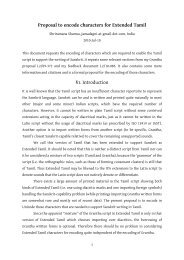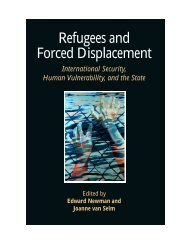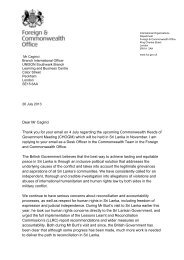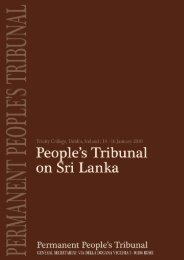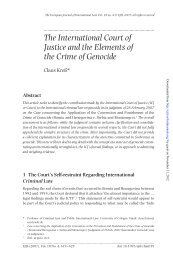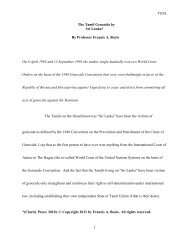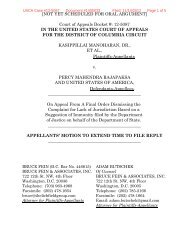TamilNet Transcription: version 1.0
TamilNet Transcription: version 1.0
TamilNet Transcription: version 1.0
You also want an ePaper? Increase the reach of your titles
YUMPU automatically turns print PDFs into web optimized ePapers that Google loves.
1<br />
<strong>TamilNet</strong> <strong>Transcription</strong>: <strong>version</strong> <strong>1.0</strong><br />
Content:<br />
CONTENT:.................................................................................................................................................... 1<br />
<strong>1.0</strong> INTRODUCTION:............................................................................................................................. 2<br />
2.0 GENERAL INSTRUCTIONS TO USERS: ................................................................................... 3<br />
2.1 TYPING TEXT IN TAMIL .................................................................................................................... 3<br />
2.2 AUTOMATED TRANSCRIPTION FOR THE TAMIL TEXT: .................................................................... 3<br />
2.3 TYPING TAMIL TEXT IN ROMAN SCRIPT:......................................................................................... 3<br />
2.4 AUTOMATION OF THE TRANSCRIPTION TO TAMIL SCRIPT: ............................................................. 3<br />
2.5 AUTOMATION TO MADRAS TAMIL LEXICON TRANSLITERATION .................................................. 4<br />
3.0 TRANSCRIPTION TABLES............................................................................................................... 5<br />
3.1 TRANSCRIPTION AND AUTOMATION KEY: TAMIL TO ROMAN ........................................................ 5<br />
3.1.1 Vowels .......................................................................................................................................... 5<br />
3.1.2 Aaytham ....................................................................................................................................... 6<br />
3.1.3 Consonants .................................................................................................................................. 6<br />
3.1.3.1 Hard Consonants ...................................................................................................................................6<br />
3.1.3.2 Soft Consonants.....................................................................................................................................8<br />
3.1.3.3 Medium Consonants .............................................................................................................................9<br />
3.1.4 Granta characters .....................................................................................................................10<br />
3.2 TRANSCRIPTION AND AUTOMATION KEY: ROMAN TO TAMIL..........................................................11<br />
3.2.1 Vowels:.......................................................................................................................................11<br />
3.2.2 Aaytham .....................................................................................................................................11<br />
3.2.3 Consonants ................................................................................................................................12<br />
3.2.3.1 Consonants: hard .................................................................................................................................12<br />
3.2.3.2 Consonants: soft ..................................................................................................................................13<br />
3.2.3.3 Consonants: medium...........................................................................................................................13<br />
3.2.4 Grantha characters ...................................................................................................................14<br />
4.0 MADRAS TAMIL LEXICON TRANSLITERATION SYSTEM ...............................................15<br />
4.1 VOWELS..............................................................................................................................................15<br />
4.2 AAYTHAM...........................................................................................................................................15<br />
4.3 CONSONANTS .....................................................................................................................................15<br />
4.3.1 Consonants: hard ......................................................................................................................15<br />
4.3.2 Consonants: soft ........................................................................................................................16<br />
4.3.3 Consonants: medium.................................................................................................................16<br />
4.4 GRANTHA CHARACTERS.....................................................................................................................16<br />
5.0 DOCUMENT HISTORY ....................................................................................................................16
2<br />
<strong>1.0</strong> Introduction:<br />
• A simple transcription system to present Tamil text in Roman script,<br />
especially for the users of Tamil/English languages.<br />
• Two-way computer automation of transcription: from text in Tamil<br />
script to transcription in Roman script and vice versa.<br />
• Linking the system with conventional Tamil-Roman transliteration.<br />
• Facilitating storage and retrieval of information.<br />
• Enhancement of the use of Tamil language in electronic<br />
communication.
3<br />
2.0 General Instructions to Users:<br />
2.1 Typing text in Tamil<br />
• For the time being, use Bamini font for typing the text in Tamil.<br />
• Those who don't have Bamini font, can download it from the Internet.<br />
• Please note that Bamini font may not show certain unused or rarely<br />
used syllables such as<br />
(ngu, gnu, gnoo, ksh) etc.,<br />
• The <strong>TamilNet</strong> <strong>Transcription</strong> will eventually be developed to adopt<br />
Unicode and other widely used character encodings for input and<br />
retrieval.<br />
• When automated to Roman script, the system is designed to capitalize<br />
the first letter after every full stop followed by a space. If not needed,<br />
you can deactivate it.<br />
• When there is a necessity to capitalize any letter in any part of the text,<br />
type a full stop immediately before that letter in the Tamil text. Such<br />
full stops not followed by a space will not be shown in the automation.<br />
2.2 Automated transcription for the Tamil text:<br />
• Any text typed in Tamil can be automated to produce a transcription in<br />
Roman script.<br />
• The <strong>Transcription</strong> is designed primarily for English readers.<br />
• Users are requested to consult the tables for familiarizing themselves<br />
with the phonology of the transcription.<br />
2.3 Typing Tamil text in Roman script:<br />
• Any normal computer keyboard in Roman script can be used.<br />
• Users are requested to familiarize themselves with the transcription<br />
tables before typing.<br />
• If you wish to present an English word or passage in the Tamil text,<br />
separate that English word or passage by typing @@ (two at signs) on<br />
both sides of the text. Example: Aanaiyi'ravu @@(Elephant Pass)@@<br />
paravaik kadal. When automated to Tamil, the text in between the<br />
signs will be retained in English. The signs will not be shown in the<br />
automation. Example: MidapwT (Elephant Pass) guitf; fly;.<br />
2.4 Automation of the transcription to Tamil script:<br />
• The English transcription in Roman script that is typed acccording to<br />
the <strong>TamilNet</strong> system can always be automated to Tamil script.
4<br />
• At present the automated Tamil text is shown in Bamini as well as in<br />
Unicode fonts. It will eventually be extended to TSCII (Tamil Standard<br />
Code for Information Interchange).<br />
• Both Bamini and Unicode fonts can be downloaded from the Internet.<br />
• Most of the Operating Systems such as Windows, MacOS and Linux<br />
support Unicode by default. However, you may need to customise the<br />
settings for Unicode character display and ensure that a Unicode<br />
enabled web-browser is used and a Unicode font with Tamil glyphs is<br />
installed in your system.<br />
2.5 Automation to Madras Tamil Lexicon Transliteration<br />
• Both the text in Tamil script and the transcription in Roman script, can<br />
be automated to produce the Madras Tamil Lexicon transliteration.<br />
• The Transliteration thus produced follows the <strong>version</strong> of the text in<br />
Tamil script.
5<br />
3.0 <strong>Transcription</strong> Tables<br />
3.1 <strong>Transcription</strong> and automation key: Tamil to Roman<br />
3.1.1 Vowels<br />
capH/uyir<br />
Tamil<br />
script<br />
Roman<br />
Alphabet<br />
Pronunciation<br />
guide<br />
m a as u in nun.<br />
near to a in apple<br />
Tamil<br />
word<br />
mwpT<br />
muprp<br />
<strong>Transcription</strong><br />
a'rivu<br />
arisi<br />
M aa as a in arm ML aadu<br />
, i as i in ink ,iy ilai<br />
as i in imp ,O<br />
izhu<br />
< ee as ee in see
6<br />
3.1.2 Aaytham<br />
Ma;jk;<br />
Tamil<br />
script<br />
Roman<br />
Alphabet<br />
Pronunciation<br />
guide<br />
Tamil<br />
word<br />
/ :h near to consonant h v/F e:hku<br />
<strong>Transcription</strong><br />
3.1.3 Consonants<br />
nka;/mey<br />
Tamil<br />
script<br />
Roman<br />
Alphabet<br />
Pronunciation<br />
guide<br />
f; k as c in cat.<br />
Pronunciation may<br />
shift towards g or h<br />
in certain instances.<br />
3.1.3.1 Hard Consonants<br />
ty;ypdk; / vallinam<br />
Tamil word <strong>Transcription</strong><br />
fy;<br />
gf;fk;<br />
kal<br />
pakkam<br />
This is not<br />
differentiated in<br />
transcription due to<br />
ambiguity and<br />
dialectal differences<br />
(Ex: akam: aham/agam;<br />
Thangkam/<br />
Thanggam).<br />
r; ch/s as ch in chin.<br />
Pronunciation may<br />
shift to s in certain<br />
instances which will be<br />
shown in the<br />
transcription.<br />
Shift to s in the<br />
beginning of words and<br />
shift towards j when ch<br />
follows gn are not<br />
transcribed due to<br />
ambiguity and dialectal<br />
differences.<br />
Ex.: cheeppu /seeppu<br />
and vagnchi / vagnji.<br />
l; d as d in did<br />
or near to tt in putt<br />
j; th near to th in thin.<br />
Pronunciation may<br />
shift towards dh (ð)<br />
mfk;<br />
jq;fk;<br />
rup<br />
mr;rk;<br />
murd;<br />
tk;rk;<br />
rPg;G<br />
tQ;rp<br />
glk;<br />
gl;lk;<br />
japH<br />
rj;jk;<br />
akam<br />
thangkam<br />
chari<br />
achcham<br />
arasan<br />
vamsam<br />
cheeppu<br />
vagnchi<br />
padam<br />
paddam<br />
thayir<br />
chaththam
7<br />
as th in then in certain<br />
instances.<br />
This is not<br />
differentiated in<br />
transcription due to<br />
ambiguity and<br />
dialetcal differences.<br />
Ex.: aanthai / aandhai;<br />
tharmam / dharmam;<br />
patham/padham)<br />
g; p as p in put.<br />
The pronunciation<br />
shift towards b in<br />
certain instances is<br />
not transcribed due<br />
to ambiguity and<br />
dialectal differences.<br />
Ex: ampalam/ambalam<br />
and payam/bayam.<br />
w; 'r / t near to r in rat.<br />
This is a retroflex r,<br />
produced by the tip<br />
of the tongue<br />
touching the deeper<br />
part of the palate in a<br />
raised position.<br />
Me;ij<br />
jHkk;<br />
gjk;<br />
gzk;<br />
mg;gh<br />
mk;gyk;<br />
gak;<br />
gwit<br />
aanthai<br />
tharmam<br />
patham<br />
pa'nam<br />
appaa<br />
ampalam<br />
payam<br />
pa'ravai<br />
When doubled and<br />
when occurs as a<br />
single consonant the<br />
pronunciation<br />
becomes similar to t,<br />
which will be shown<br />
in the transcription.<br />
Fw;wk;<br />
,aw;if<br />
kuttam<br />
iyatkai
8<br />
Tamil<br />
script<br />
Roman<br />
Alphabet<br />
Pronunciation<br />
guide<br />
3.1.3.2 Soft Consonants<br />
nky;ypdk; / mellinam<br />
Tamil word<br />
<strong>Transcription</strong><br />
q; ng as ng in ring gq;F pangku<br />
Q; gn as ñ in spanish QhapW<br />
señor<br />
gQ;R<br />
z; 'n Retroflex sound of gzk; pa'nam<br />
n. Near to ne in one<br />
tz;zk;<br />
as n in no. epyk; nilam<br />
e; n<br />
(Tamil -><br />
Roman)<br />
:n<br />
(Roman -><br />
Tamil)<br />
As a single<br />
consonant, when<br />
followed by th, it is<br />
pronunced similar<br />
to n in month.<br />
ge;J<br />
gnaayi'ru<br />
pagnchu<br />
va'n'nam<br />
panthu<br />
This is not<br />
differentiated in<br />
transcription.<br />
k; m as m in man kjp<br />
mk;kp<br />
d; n pronunciation is<br />
similar to n in sand.<br />
The subtle<br />
difference in<br />
pronunciation<br />
between d; and e;,<br />
outlined in the<br />
grammatical texts is<br />
not shown in the<br />
transcription.<br />
kdk;<br />
td;dp<br />
mathi<br />
ammi<br />
manam<br />
vanni
9<br />
Tamil<br />
script<br />
Roman<br />
Alphabet<br />
Pronunciation<br />
guide<br />
H r/t The palatal sound<br />
of r, produced by<br />
the tip of the<br />
toungue stroking<br />
the front part of<br />
the palate.<br />
No exact<br />
equivalent in<br />
English.<br />
In certain<br />
instances, when<br />
preceded by n, it<br />
may be<br />
pronounced as t.<br />
3.1.3.3 Medium Consonants<br />
,ilapdk; / idaiyinam<br />
Tamil word<br />
a; y as y in yard tay;<br />
gha;<br />
ePH<br />
kuk;<br />
vd;iu<br />
<strong>Transcription</strong><br />
vayal<br />
paay<br />
neer<br />
maram<br />
entai<br />
y; l as l in love ,y;yk; illam<br />
t; v as v in voice ts;sk;<br />
ntsthy;<br />
gok;<br />
tho;f;if<br />
jkpo;<br />
o; zh Retroflex sound of<br />
l, produced by the<br />
tip of the tongue<br />
touching the<br />
deeper part of the<br />
palate in a raised<br />
position.<br />
va'l'lam<br />
vauvaal<br />
pazham<br />
vaazhkkai<br />
Thamizh<br />
No equivalent in<br />
English or in<br />
Indian languages<br />
other than Tamil<br />
and Malayalam.<br />
s; 'l Palatal sound<br />
of l, produced by<br />
the tip of the<br />
tongue, gently<br />
touching the<br />
palate.<br />
Near to l in temple<br />
Fsk;<br />
gs;sk;<br />
ku'lam<br />
pa'l'lam
10<br />
3.1.4 Granta characters<br />
fpue;j vOj;Jf;fs;<br />
Tamil<br />
script<br />
Roman<br />
Alphabet<br />
Pronunciation<br />
guide<br />
Tamil word<br />
<strong>Transcription</strong><br />
[; j as j in June n[ak; jeyam<br />
]; s<br />
(Tamil -><br />
Roman)<br />
's<br />
(Roman -><br />
Tamil)<br />
as s in sing t];J vasthu<br />
\; sh as sh in crash G\;gk; pushpam<br />
`; h<br />
(Tamil -><br />
Roman)<br />
as h in hat `up hari<br />
'h<br />
(Roman -><br />
Tamil)<br />
Ñ; ksh combination of k<br />
= s'ree<br />
(Tamil -><br />
Roman)<br />
and sh<br />
combination of<br />
palatal 's', r and ee<br />
yÑ;kp<br />
lakshmi<br />
=y = s'reela s'ree<br />
s'ree/sree<br />
(Roman -><br />
Tamil)
11<br />
3.2 <strong>Transcription</strong> and automation key: Roman to Tamil<br />
3.2.1 Vowels:<br />
Roman<br />
a<br />
Tamil<br />
m<br />
aa M<br />
i ,<br />
ee <<br />
u<br />
oo<br />
e<br />
ea<br />
ai<br />
o<br />
oa<br />
au<br />
c<br />
C<br />
v<br />
V<br />
I<br />
x<br />
X<br />
xs<br />
3.2.2 Aaytham<br />
Roman Tamil Notes<br />
:h / Used rarely in classical Tamil.<br />
There is a feature called a'lapedai, for elongation of vowel sounds in classical<br />
Tamil. Aadoou (M^c) has to be read with an elongation of sound for oo. The<br />
elongation is equivalent to u, means the total length of sound is equivalent to<br />
three u's. Note this feature when classical texts are involved in transcription.
12<br />
3.2.3 Consonants<br />
3.2.3.1 Consonants: hard<br />
Roman<br />
k<br />
kh<br />
g<br />
gh<br />
h<br />
Tamil Notes<br />
f;<br />
Any of the listed Roman characters can be<br />
typed to produce f; (k) in Tamil.<br />
In the beginning of words and when occurs as a<br />
single consonant, h will be automated to `; (h).<br />
In other instances, it will become f; (k).<br />
However, when typed in Tamil, f; (k) will<br />
always be automated to k in Roman.<br />
ch<br />
s<br />
r;<br />
ch will always be automated to r; (ch).<br />
s will be automated to ]; (s) in the beginning of<br />
words and when occurs as a single consonant.<br />
In other instances, it will be automated to r; (ch).<br />
d l;<br />
j;<br />
th<br />
dh<br />
p<br />
ph<br />
b<br />
bh<br />
'r<br />
t<br />
When typing in Tamil, r; (ch) will be automated<br />
to s in Roman when it occurs between two<br />
vowels and when it follows soft or medium<br />
consonants. In other instances, it will be<br />
automated to ch in Roman.<br />
Both can be automated to the Tamil character j;<br />
(th).<br />
However, when typing in Tamil, j; (th) will<br />
always be automated to th in Roman.<br />
Any of the Roman characters listed can be<br />
g;<br />
typed for the automation to g; (p).<br />
While typing in Tamil, g; (p) will always be<br />
automated to p in Roman.<br />
With combinations of vowel, 'r will be<br />
w;<br />
automated to w ('ra) etc.<br />
When occurs as a single consonant and when<br />
doubled, t can be typed to produce w;.<br />
The vowel consonant w ('ra) etc., following an<br />
w; in doubled instances can be produced by<br />
typing tt.<br />
Even an 'r or 'r'r will be automated to w; or w;w<br />
etc., by default.<br />
When typing in Tamil, w ('ra) etc., will be<br />
automated to 'r in Roman. But, w; ('r) and w;w<br />
etc., will be automated to t and tt in Roman.
13<br />
3.2.3.2 Consonants: soft<br />
ng q;<br />
gn Q;<br />
'n z;<br />
n<br />
:n<br />
e;<br />
When preceds j; (th) and in the beginning of<br />
words, n will be automated to e;, e etc.<br />
In other instances it will become d;.<br />
In combinations of words such as nte;ePH and in<br />
certain instances of sanskrit words and personal<br />
names such as me;epaH. tpGyhee;jH etc., e may<br />
occur in the middle of words. In such instances,<br />
users are requested to type :n to produce the<br />
Tamil script e.<br />
While typing in Tamil, both e; and d; are<br />
automated to n in Roman. They are not<br />
differentiated in the transcription.<br />
m k;<br />
n d;<br />
Except in the beginning of words and in<br />
combinations followed by th, n will be<br />
automated to d;. The said circumstances don't<br />
occur involving d; in Tamil language.<br />
Therefore, d; is safely automated from Roman n<br />
to Tamil d; (see e;).<br />
When typing in Tamil, d; and e; are automated<br />
to n in Roman.<br />
3.2.3.3 Consonants: medium<br />
y a;<br />
r<br />
t<br />
l y;<br />
v<br />
w<br />
zh o;<br />
'l s;<br />
H<br />
r will always be automated to H.<br />
There are instances where H (r) after d; (n), is<br />
pronounced t. In words, such as mtd;iu><br />
vd;iu (avantai, entai) etc., t can be typed to<br />
automate H.<br />
When typing in Tamil, H can be automated to r<br />
in Roman.<br />
In instances where vowel consonants of H follow<br />
d;> the automation will be t in Roman.<br />
t;<br />
Both can be automated to t in Tamil.<br />
However, t will always be automated to v in<br />
Roman.
14<br />
3.2.4 Grantha characters<br />
j [;<br />
's<br />
s<br />
sh \;<br />
'h<br />
h<br />
];<br />
In the beginning of words and when occurs as a<br />
single consonant s will be automated to ]; in<br />
Tamil.<br />
In other instances, s will produce r; (ch) in<br />
automation.<br />
's can be typed to produce ]; on any occasion.<br />
When typing in Tamil, ]; will always be<br />
automated to s in Roman.<br />
`;<br />
In the beginning of words and when occurs as a<br />
single consonant, h will be automated to `; in<br />
Tamil.<br />
In other instances h will be automated to f; (k).<br />
Typing 'h will produce `; on all occasions.<br />
ksh<br />
s'ree<br />
sree<br />
f\;<br />
When typing in Tamil `; will always be<br />
automated to h.<br />
=<br />
As a combination of letters, both s'ree as well as<br />
sree, can be automated to =.<br />
However, when typed in Tamil, = can only be<br />
automated to s'ree.
15<br />
4.0 Madras Tamil Lexicon Transliteration System<br />
4.1 Vowels<br />
Tamil alphabet Transliteration in Roman<br />
m<br />
a<br />
M<br />
ā<br />
, i<br />
< ī<br />
c<br />
u<br />
C<br />
ū<br />
v<br />
e<br />
V<br />
ē<br />
I<br />
ai<br />
x<br />
o<br />
X<br />
ō<br />
xs<br />
au<br />
4.2 Aaytham<br />
Tamil alphabet Transliteration in Roman<br />
/ ḵ<br />
4.3 Consonants<br />
4.3.1 Consonants: hard<br />
Tamil alphabet Transliteration in Roman<br />
f; k<br />
r; c<br />
l; ṭ<br />
j; t<br />
g; p<br />
w; ṟ
16<br />
4.3.2 Consonants: soft<br />
Tamil alphabet Transliteration in Roman<br />
q; ṅ<br />
Q; ñ<br />
z; ṇ<br />
e; n<br />
k; m<br />
d; ṉ<br />
4.3.3 Consonants: medium<br />
Tamil alphabet Transliteration in Roman<br />
a; y<br />
H<br />
r<br />
y; l<br />
t; v<br />
o; ḻ<br />
s; ḷ<br />
4.4 Grantha characters<br />
[; j<br />
]; s<br />
\; ṣ<br />
`; h<br />
f\;<br />
kṣ<br />
= sri<br />
5.0 Document History<br />
Date Version Comment<br />
April 28, 2007 Beta 1 Trial<br />
June 01, 2007 <strong>1.0</strong> Improved and modified<br />
after feedbacks<br />
June 02, 2007 <strong>1.0</strong> Typo in A'risi. Changed to<br />
Arisi in table 3.1.1



